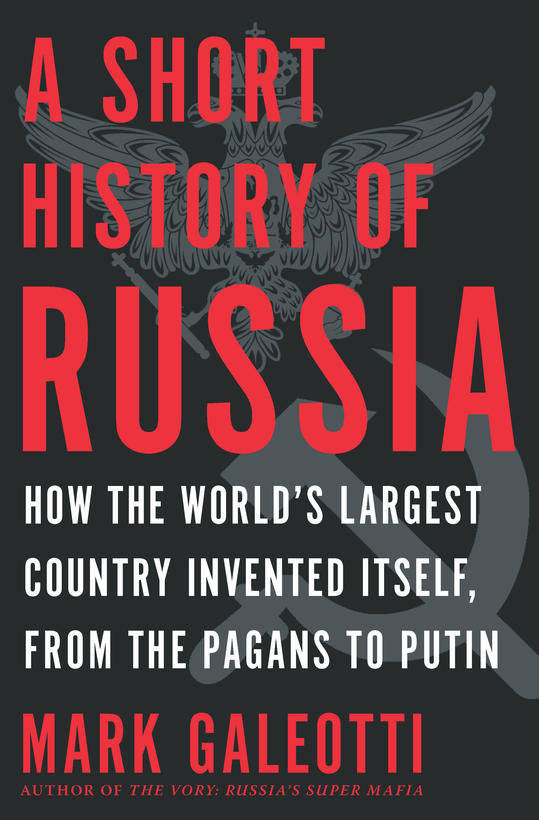It is impossible to understand Putin, or modern Russia’s prickly interaction with the rest of the world, without understanding his predecessors. In A Short History of Russia, a solid, if occasionally workmanlike, recitation of the full sweep of Russian history, skilled Russia analyst Mark Galeotti focuses less on unpacking the thematic cycles of Russian history than on packing in an overview of its leaders. And he crams it all into 216 pages—particularly useful for those seeking to dip their toe into Russian political history.
Galeotti begins, well, at the beginning.
Russia is a land of scattered towns in the 9th century until conquering Viking princes bring a semblance of unity to the country. Prince Vladimir adopts Orthodox Christianity from Constantinople in 988, saddling Russia with its Byzantine heritage—including Russia’s enduring exceptionalist view of itself as the “Third Rome” (Rome, then Constantinople, then Moscow), carrying the torch of Christian civilization. All seems to be progressing smoothly until the Mongol Horde invades from the East in a destructive rampage in 1237 and, three years later, burns Kiev—then Russia’s capital—to the ground. This initiates the period of the “Mongol Yoke,” during which the city state of Moscow rises in influence and eventually leads the Russians in overthrowing the Mongols in 1480.
Enter Ivan the Terrible (r. 1533–1584), who adopts the title Tsar (derived from “Caesar,” another Byzantine inheritance), ruthlessly consolidates the country, and expands its borders in the search of power and “soft gold” (fur). But a succession crisis soon plunges Russia into its “Time of Troubles” (1605–13), during which chaos and war ravage the country, inviting invasions by the Poles and Lithuanians. To many Russians, including Putin, the Time of Troubles reinforces a critical historical through line memorably articulated to Galeotti by a former KGB officer: “either we [hold] the country in a tight fist, or else it [will] fall apart.”
Ivan the Terrible adopts the title Tsar (derived from “Caesar”) and expands Russia’s borders in search of “soft gold” (fur).
Unifying the state was a task for Peter the Great (r. 1682–1725), Russia’s towering (quite literally—Peter was 6’8”) modernizer who harbored a fascination with the West. Fueled by a prodigious will, Peter drags Russia kicking and screaming into Europe: he builds a modern European army, expands Russia’s borders to the Baltic Coast, founds and moves Russia’s capital to St. Petersburg (his “window on Europe”) in 1703, and imposes Western fashions and manners on horrified Russians. Notably, Galeotti is comparatively unsympathetic toward Peter. He emphasizes Peter’s militarism and autocratic nature relative to other historians, like Robert Massie, who highlight Peter’s European vision and beneficent impact on Russia’s trajectory.
“Either we [hold] the country in a tight fist, or else it [will] fall apart.”
That Western trajectory accelerates under Catherine the Great (r. 1762–96), Russia’s enlightened despot par excellence who corresponded with Voltaire and Diderot, brought European artistic tastes to St. Petersburg, and expanded Russia’s borders farther west and south. Russia’s power then peaks after Alexander I repulses Napoleon’s disastrous invasion of Russia in 1812 and chases the French all the way back to Paris. (Though likely apocryphal, some say that the French Bistro derives from this historical moment, as enterprising Parisian restaurateurs targeted Russian officers looking for a fast meal, “bistro” in Russian meaning “quickly”). The remainder of the 19th century sees Russia falling behind the rest of Europe given its repressive autocracy and backward, serf-based economy. World War I, and the flaccid leadership of Nicholas II, seal the regime’s fate as the Russian Revolution takes hold in 1917 and condemns Tsarist Russia to the dustbin of history.
Galeotti speeds through Soviet history in one chapter, though rightly stopping to highlight the importance of W.W. II, and Stalin, in the Russian historical imagination. The Soviet Union lost over 20 million lives in the “Great Patriotic War”; compare that to America’s 420,000. In the 1980s Gorbachev initiates a period of reform that unintentionally unwinds the Soviet Union, leading to the dissolution of the U.S.S.R. in 1991. The chaotic 1990s can be seen as a continuation of this economic and political unwinding, until Putin consolidates power in 2000, “lifting Russia from its knees” and restoring stability (rising oil prices during the 2000s certainly helped).
In the end, Putin seems to be an avatar of two stylized lessons Russians draw from their history: first, that when Russia isn’t unified under a strong state it becomes prone to chaos and foreign meddling; and second, given Russia’s lack of natural borders, securing its periphery requires constant expansion and the creation of a “sphere of influence” around it (hence Russia’s desire to bring countries like Ukraine and Georgia under its boot). In the age of telecommunications, fighter jets, and nuclear weapons, these lessons are surely anachronistic. But Putin shows us how deeply the echoes of history reverberate in the Russian psyche, alongside a healthy amount of exceptionalism and national ego. As Galeotti quotes from Karl Marx, “Traditions of dead generations weigh like a nightmare on the minds of the living.”
Theodore Bunzel worked in the political section of the U.S. Embassy in Moscow and in international economics at the U.S. Treasury. He lives in New York City
